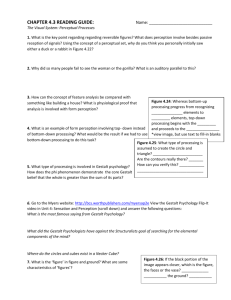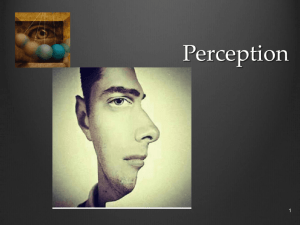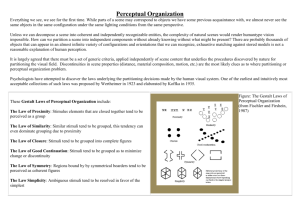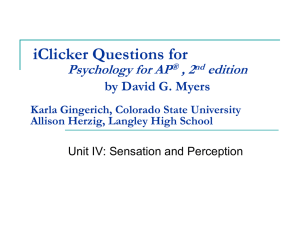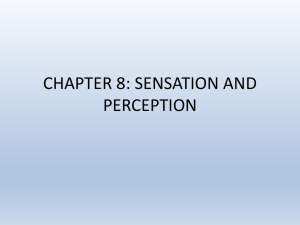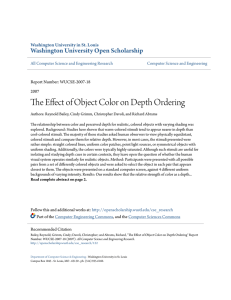VIEWING THE WORLD IN COLOR
advertisement
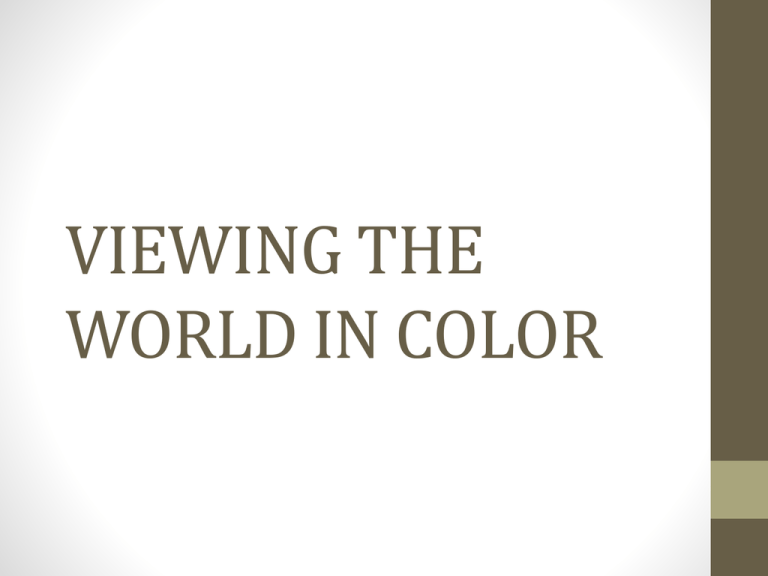
VIEWING THE WORLD IN COLOR COLOR • • • • A psychological interpretation Based on wavelength, amplitude, and purity Humans can discriminate among c. 10 million colors Variations are a result of mixing… COLOR • Subtractive mixing: removing some wavelengths of light, leaving less light than was originally there • Additive color: superimposing lights, putting more light in the mixture than exists in any one light itself TRICHROMATIC THEORY OF COLOR VISION • Holds that the human eye has 3 types of receptors with differing sensitivities to different light wavelengths • Helmholtz: red, green, and blue---the primary colors COLOR BLINDNESS • Encompasses a variety of deficiencies in the ability to distinguish among colors • More frequent in males • Most are dichromats OPPONENT PROCESS THEORY OF COLOR VISION • Holds that color perception depends on receptors that make antagonistic responses to 3 pairs of colors • Complementary colors: colors that produce gray tones when mixed together • Afterimage: a visual image that persists after a stimulus is removed RECONCILING THEORIES OF COLOR VISION • It takes both theories to explain color vision • George Wald: eye has 3 types of cones---trichromatic theory • DeValois: cells throughout the eye respond in opposite ways to red vs. green and blue vs. yellow---opponent process PERCEIVING FORMS, PATTERNS, AND OBJECTS • Reversible figure: a drawing that is compatible w/2 interpretations that can shift back and forth • Demonstrates same visual input can result in radically different perceptions • Perceptual set: a readiness to perceive a stimulus in a particular way FEATURE ANALYSIS • The process of detecting specific elements in visual input and assembling them into a more complex form BOTTOM-UP/TOP-DOWN • Bottom-up processing: a progression from individual elements to the whole • Top-down processing: a progression from the whole to the elements LOOKING AT THE WHOLE: GESTALT PRINCIPLES • The whole can be more than the sum of its parts • Phi phenomenon: the illusion of movement created by presenting visual stimuli in rapid succession GESTALT PRINCIPLES • Figure and ground: figure is thing being looked at and ground is the background • Figures have more substance and shape, and appear closer GESTALT PRINCIPLES • • • • • Proximity: things near one another seem to belong together Similarity: we group things that are similar Continuity: tendency to follow the direction you are led Simplicity: organize in simplest way possible Closure: group in order to create completeness FORMULATING PERCEPTUAL HYPOTHESES • Distal stimuli: stimuli that lie in the distance (outside the body) • Proximal stimuli: the stimulus energies that impinge directly on sensory receptors • Perceptual hypothesis: an inference about which distal stimuli could be responsible for the proximal stimuli sensed PERCEIVING DEPTH AND DISTANCE • Depth perception: interpretation of visual cues that indicate how near or far away objects are • We rely on different clues classified in 2 types… BINOCULAR CUES • Def: clues about distance based on the differing views of the 2 eyes • Principle depth cue is retinal disparity: the fact that objects within 25 ft project images to slightly different locations on the right and left retinas, so the right and left eyes see slightly different views of the object • Another cue is convergence: sensing the eyes converging toward each other as they focus on closer objects MONOCULAR CUES • Def: clues about distance based on the image in either eye alone • Motion parallax: images of objects at different distances moving across the retina at different rates MONOCULAR CUES • Pictorial depth cues: clues about distance that can be given in a flat picture • Includes linear perspective, texture gradients, interposition, relative size, height in plane, and light and shadow PERCEPTUAL CONSTANCIES IN VISION • Perceptual constancy: a tendency to experience a stable perception in the face of continually changing sensory input OPTICAL ILLUSIONS • Def: an apparently inexplicable discrepancy btwn the appearance of a visual stimulus and its physical reality • Müller-Lyer Illusion • Ponzo Illusion • Shepard Illusion • Ames Room IMPOSSIBLE FIGURES • Def: objects that can be represented in 2 dimensional pictures but cannot exist in 3 dimensional space
